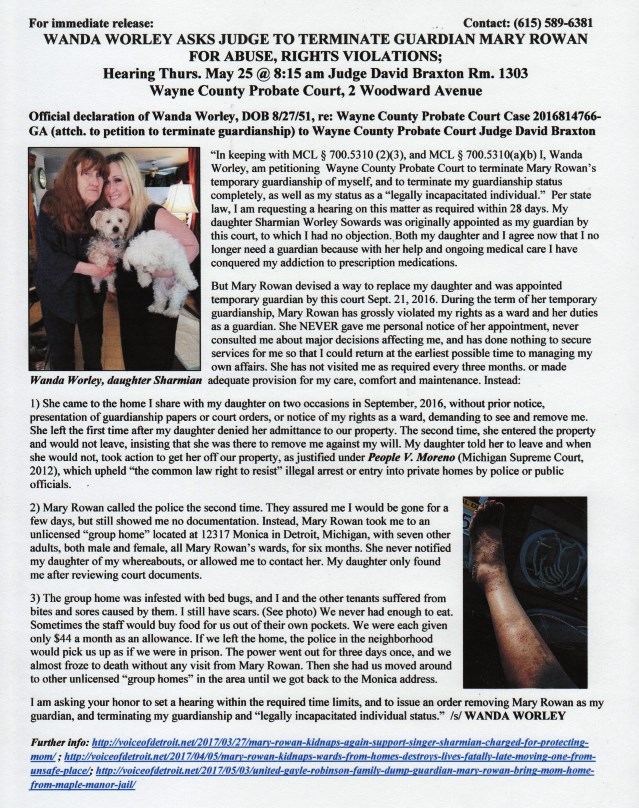VOD NEEDS DONATIONS NOW–LINKS IN STORIES
VOD WELCOMES NEW SUBMISSIONS!
If you want to be published on VOD, please submit your articles, etc. to diane_bukowski@hotmail.com. Call 313-825-6126 to alert us.-
Recent Posts
- SENTINEL REPORT: KYM WORTHY, CIU’s, DPD, SADO LEAVE MASSES OF WRONGLY CONVICTED TO ROT AND DIE IN MDOC
- FREE WRONGLY CONVICTED LIFER DAVID MCKINNEY, CHARGE INKSTER COPS ANTHONY DELGRECO, OTHERS
- LET OUR BROTHERS GO! RICKY RIMMER, GREGORY ALLEN, DESHON STOKES! SAT. OCT. 11 @12 NOON MLK JR. HIGH
- WRONGLY CONVICTED, MICHEAL ‘MIKE D’ DEGRAFFINRIED FREED AFTER 26 YRS; NEW TRIAL HEARINGS OCT. 9, NOV. 11
- COUNCIL CANDIDATE JAMES HARRIS’ S.T.R.E.S.S. COP, DRUG DEALER DAD BUSTED BY FEDS; SPENT 20 YRS. IN PRISON
- WOMEN AT HURON VALLEY PRISON WIN FED. COURT RULING BLASTING HORRIFIC CONDITIONS, DENYING MDOC IMMUNITY
- FREE RICKY RIMMER! DETROIT MAYORAL CANDIDATE ATTY. TODD PERKINS MEETS WITH RR’S SUPPORTERS JUNE 8
- DONATE TO VOD BEFORE JUNETEENTH! KEEP STORIES OF CONVICTIONS BY CROOKED COPS, PROSECUTORS ON-LINE
- CEDRIC TOOKS HOME AFTER 47 YRS, RESENTENCED AS 18-YR. OLD JUVENILE, LEADS WAY FOR HUNDREDS MORE
- MICH. SUPREME COURT ORDERS RESENTENCINGS FOR LIFERS AGED 18, 19, 20, AFFECTING AT LEAST 830 IN MDOC
- WE REMEMBER AFENI SHAKUR JAN. 10, 1947 – MAY 2, 2016; “BLACK PANTHER PARTY HISTORY IS WOMEN’S HISTORY”
- PROF. PENNY GODBOLDO, DR. MARGARET BETTS SPONSOR “MEDITATION MOVEMENT & MEDICINE” SAT. MAR. 29 10A-2P
- MICH. SUPREME COURT TO RULE RE: LIFERS CONVICTED UNDER 21, OTHERS CHARGED WITH FELONY MURDER
- DUGGAN’S DECADES-LONG DETROIT DEMOLITION DERBY
- ATTEND FRIENDS OF RETURNING CITIZENS (F.O.R.C.) SUPPORT GROUP MEETINGS TUESDAYS 6 – 7:30 PM
- EXONEREE THELONIOUS SEARCY PACKS COURT; JUDGE DELAYS RE-TRIAL, DENIES TETHER REMOVAL PER NESSEL
- FREE DOUBLE R IN 2025! DETROIT PROTESTS FOR RICKY RIMMER FORCED ACTION, CASE GOING TO APPEALS COURT
- CHARGES DISMISSED VS. DEMETRIS ‘MEECH’ KNUCKLES EL, COUSIN JAN. 16, 2025; TONS OF SUPPORTERS SHOWED
- FIGHT THE POWER! JOIN THELONIOUS ‘SHAWN’ SEARCY IN COURT FRI. JAN. 10 VS. ‘INNOCENCE DENIER’ KYM WORTHY
- DONATE TO VOD IN 2025! HELP EXPOSE CRIMES OF COPS, PROSECUTORS, JUDGES WHO FRAMED 1,000’S IN MDOC
- GAYELON SPENCER, JR. FIGHTS MURDER 2 CONVICTION: COPS DESTROYED EVIDENCE, BIASED MEDIA COVERAGE
- WILLIE MERRIWEATHER MEMORIAL SAT. DECEMBER 14, 4PM: HERO WHO GAVE HIS LIFE TO SAVE OTHERS FROM PRISON
- DIRTY DETROIT COPS BEAT, MADE UP CONFESSIONS FROM ALTON HUBBARD, BROTHER IDOLTHUS, IN 2004 MURDERS
- ROGER CARLOS RAY WINS EVIDENTIARY HEARING ON 3RD TRY; EXONEREE LAVONE HILL CALLS FOR RAY’S RELEASE
- ‘MIKE D’ NOT THE SHOOTER, VICTIM OF 1999 INKSTER DRIVE-BY SAYS; OIC DARIAN WILLIAMS CONVICTED OF EXTORTION
Monthly Archives
Links
- Al Jazeera news
- All of Us Or None, prisoners and former prisoners
- All-African People's Revolutionary Party
- American Tribune, the prison experience
- Black Agenda Report
- Black is Back Coalition
- Black List
- Block Report Radio
- Color Lines
- DBA Press
- Defend Freedom of the Press
- Detroit Parents with Special Ed Students
- Free Mumia Abu Jamal
- Free Mumia Abu Jamal news
- Gray Zone
- Hood Research
- Jamahiriya News Agency–Free Libya
- Kenny Snodgrass: You Tube
- Labor Notes
- Libya 360
- Mac Speaking: Leona McElvene YouTube site
- Maryanne Godboldo
- MI Emergency Ctte. v War & Injustice
- Michigan Welfare Rights Organization
- Monthly Review Online
- Nadir's Detroit music scene
- Photography is Not a Crime
- Press TV world news
- Prison Legal News
- Project B.A.I.T.
- Real News Network
- Russia Today
- San Francisco Bay View newspaper
- SCG News: World News, Politics and Analysis
- THE GRAYZONE
- We the People of Detroit
- Wikileaks
RECALLING DETROIT’S 1967 REBELLION AND THE RACIST VIETNAM WAR: TIME FOR AFRICAN LIBERATION DAY!
Posted in Uncategorized
Leave a comment
END GUARDIAN ABUSE! SUPPORT WANDA WORLEY, SHARMIAN V. MARY ROWAN, THURS. MAY 25
Posted in Uncategorized
1 Comment
WILLIAM KEITH JENKINS-BEY (JENKO A/K/A JENKS) JOINS THE ANCESTORS




William Keith Jenkins-Bey was a beloved member of his family, and a well-respected leader in his community both inside the walls and in the world. He will be sorely missed by all.
Posted in Uncategorized
Leave a comment
PUERTO RICO: $123B BANKRUPTCY UNDERWAY; AS IN DETROIT, BANKS WANT WORKERS, POOR TO PAY
Hospitals, schools and transport shut down in Puerto Rico on May Day, as thousands marched to the financial center in San Juan to denounce cuts and privatizations expected under the government’s $123 billion bankruptcy filing May 3. The U.S. Congress created a new Chapter III bankruptcy law especially for Puerto Rico in its 2015-16 session. Unions and social movements say workers would pay the price in the largest bankruptcy filing in U.S. history, dwarfing even Detroit’s.

Many bankruptcy opponents demanded complete cancellation of Detroit’s debt to the banks, blaming them for the city’s crisis.
May 17, 2017–Federal U.S. Court proceedings on Puerto Rico’s $123 billion bankruptcy filing, likely to cause terrifying flashbacks for Detroit’s public workers and residents, began today.
In Detroit, public union leaders and others capitulated to a disastrous bankruptcy plan in 2014, which stole nearly all the city’s assets including its crown jewel, the $6 billion Detroit Water and Sewerage Department. The theft of DWSD led directly to the criminal lead poisoning for profit of the people of Flint. Chapter IX bankruptcy provisions forbids the takeover of a municipality’s assets “unless the municipality agrees.” U.S. District Court Judge Steven Rhodes recognized state-appointed Emergency Manager Kevyn Orr as “the city of Detroit.” Orr agreed to this wholesale rape of the largest Black majority city in the country.
The city’s debt rose 300 percent as the banks got paid under a state-enforced emergency manager. City workers, retirees, and residents took devastating cuts to their wages, health benefits, pensions and services.
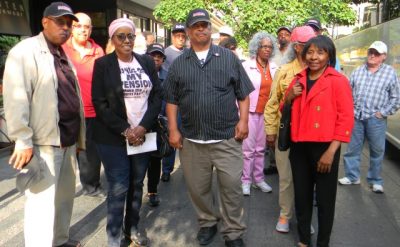
DAREA members disembark from bus in Cincinnati June 15, 2016 to pack 6th Circuit Court in support of their bankruptcy lawsuit. In center is DAREA President Bill Davis, to his right is DAREA VP Cecily McClellan. At far right is retiree Ezza Brandon. The case has now moved on to the U.S. Supreme Court.
Meanwhile, however, various independent coalitions of retirees, including the Detroit Active and Retired Employee Association (DAREA) have sued the federal government over the bankruptcy, and are currently awaiting a decision from the U.S. Supreme Court over whether they will hear the case.
But in Puerto Rico, which has a long history of struggles for independence from the U.S., a much more militant fightback began with a general strike May 1. The outcome of THESE proceedings will depend on the workers’ determination to fight for victory. Below are excerpts from articles in Bloomberg and Telesur on Puerto Rico’s battle.
Video above: Miller Buckfire was a key player in Detroit bankruptcy.
HEDGE FUNDS VIE WITH PUERTO RICO WORKERS OVER GETTING PAID FIRST
Commonwealth’s pension systems set to go broke this year
Island’s $123 billion bankruptcy biggest in municipal history
 By Michelle Kaske and Steven Church
By Michelle Kaske and Steven Church
May 12, 2017 5:00 AM EDT
The message in Puerto Rico is blunt: pay us, not Wall Street.
Anger over the biggest municipal bankruptcy in U.S. history has centered on the urgent question of public pensions. Puerto Rico has promised its workers and retirees $49 billion in benefits, but it’s guaranteed bondholders even more.
The pension system is scheduled to run out of money as soon as July, and many on the island fear, with benefit cuts already under discussion, that the hedge funds who own one-third of the commonwealth’s bonds will wrangle a better deal than ordinary Puerto Ricans.

U.S. District Court Judge Laura Taylor Swain
“The whole situation is unfair,” said Maria Rodriguez, a 64-year-old retired employee of the Public Building Administration. “I worked for over 35 years for the government and now it’s apparently clear that my pension will be cut by at least 10 percent. This is the result of the actions of multiple administrations from both parties.”
It’s a no-win situation for Puerto Rico and its 3.5 million people. Schools are being closed, talented residents are leaving and the economy has been contracting for years.
That’s the mess confronting U.S. District Judge Laura Taylor Swain as the adversaries face off for the first time in federal court May 17 in San Juan. They’ll be tussling over $123 billion owed to retirees and creditors.

Massive May Day strike in Puerto Rico May 1, 2017. Black and white Puerto Rican flag is symbol of independence from U.S.
‘Don’t Care’
In pre-hearing rhetoric, labor groups are painting rich hedge funds as uncaring vultures looking to extract money from less-wealthy public workers. The creditors say there would be more money for everyone if Puerto Rico improved its revenue collections and thinned its hulking government bureaucracy.
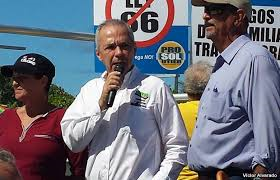
Emilio Nieves, Pres. of PR National Union of Educators and Education Workers
“Hedge funds don’t care what happens to the people, they want to get more profits,” said Emilio Nieves, president of Puerto Rico’s National Union of Educators and Education Workers. “They are our oppressors. We will resist and the government of Puerto Rico must decide if they are in favor of the people or the bondholders.”
Puerto Rico must decide if they are in favor of the people or the bondholders.
Average annual pension benefits are $14,000, according to Puerto Rico’s federal oversight board, and roughly one-third of employees are ineligible for Social Security benefits. Nearly half of island residents live in poverty and the median household income is $19,350, compared with $53,889 in the 50 states, according to U.S. Census data.
The commonwealth’s federal oversight board anticipates a 10 percent cut in pension expenses. That’s more generous than what Governor Ricardo Rossello offered bondholders in his latest public proposal. General-obligation bonds, or GOs, which the island’s constitution says must be repaid before other bills, would receive a best-case recovery of 90 cents on the dollar. Since that estimate depends on an improvement in the government’s finances, the recovery could be as low as 70 percent.
Divide Payments
Rossello’s fiscal plan would pay bondholders less than a quarter of what they’re owed in principal and interest through 2026. The government hasn’t said how they would divide those payments, or which group is first in line.
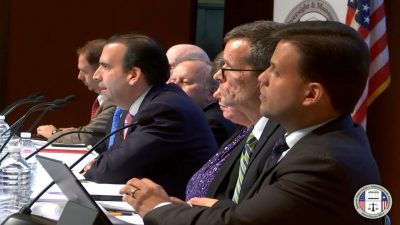
Puerto Rico’s “Federal Oversight Board” is appointed by the U.S. President. The City of Detroit and its new school district are similarly overseen by the State of Michigan.
“As much as there were promises made to various stakeholders on the island — pensioners, current government employees or contractors who work for the government — those are all implicit promises,” said David Tawil, president and co-founder of Maglan Capital LP in New York, who bought Puerto Rico bonds in 2013 but has since sold them. “The bondholders have explicit promises whether they be in offering documentation or whether they be pursuant to the constitution.”
The court hearing comes two weeks after Puerto Rico’s federal oversight board filed a form of bankruptcy called Title III to help reduce its $74 billion [now re-estimated at $123B] of debt and tackle its unfunded pension crisis. It will be the largest restructuring in the history of the $3.8 trillion municipal-bond market.
Title III, a provision in the Puerto Rico relief law that [the U.S.] Congress passed last year, is the only way for the island to force pension recipients to accept benefit cuts in court. Puerto Rico needed to pursue Title III in part because of its pension crisis, the board wrote in its May 3 filing. Another negotiating provision called Title VI didn’t include retirement savings. (To see bill passed by U.S. Congress without representation of Puerto Rican people, go to http://voiceofdetroit.net/wp-content/uploads/Puerto-Rico-HR-4199-bill.pdf.)
PUERTO RICO NATIONAL STRIKE PROTESTS ‘COLONIAL’ DEBT CRISIS
Nearly half the alleged $132B debt is interest to banks and hedge funds
More than $30B in debt issued illegally
Washington’s austerity prescription is hitting workers and students hard
6o percent of Puerto Rican children live in poverty; Detroit’s child poverty rate is 59 percent
TeleSUR

Puerto RIcans rise up against oppression by U.S. and banks.
May 1, 2017–Thousands of Puerto Rican workers, students and other demonstrators took to the streets in a national strike in the early hours of International Workers’ Day Monday to protest against the harsh austerity measures pummeling the island and the controversial federal control board managing its economy and crippling debt load.
RELATED: Puerto Rico Resistance Heats up as Major Cuts Target Education
The strike shut down businesses and blocked several streets, including traffic to the Luis Muñoz Marin international airport on the outskirts of the city as well as to the University of Puerto Rico, while dozens of others gathered at the offices of the Department of Labor in the capital’s Hato Rey area to prepare for a thousands-strong march on the financial district.

University of Puerto Rico students mass in streets.
Demonstrators carried signs with slogans against U.S. colonialism and against the neoliberal austerity measures targeting the island’s public education, health care, social security and other public services. Protesters chanted slogans including “Ricky is selling the island!” to criticize Governor Ricardo Rossello, while others marched with images of the Puerto Rico flag in black and white as a symbol of resistance amid crisis on the island.
Marches led by students, feminists, trade unionists and other groups began by congregating at five points in the city and later converged by late morning in the one-mile stretch of San Juan’s Ponce de Leon Avenue, known as the Golden Mile, where the controversial U.S. president-appointed fiscal control board steering the island’s economy is headquartered in the heart of the city’s financial center.

Juan Camacho at right with other Puerto Rican organizers
The fiscal control board — set up last year through the contentious PROMESA law that gained bipartisan support in the U.S. Congress as a plan to save Puerto Rico from its nearly US$73 billion debt crisis — has become a powerful symbol of the island’s colonial relationship with Washington and the sacrificing of basic rights in the name of servicing the island’s unmanageable debt load.
“This debt cannot be paid from the pocket of the workers,” community leader Juan Camacho said during the demonstrations.
RELATED: Puerto Rico Lays Groundwork for Upcoming Vote on Statehood
Puerto Rican artist Rene Perez, known as Residente, also joined the marches and addressed the demonstrators. Wearing a T-shirt promoting free public education, the famed rapper said he was proud to see the massive strike against the debt and in favor of workers’ and students’ rights.
“I’m very certain that is happening is completely unjust,” he said on stage to a large crowd, giving a shout out to students of the University of Puerto Rico, the island’s main public post-secondary education system with a total of 11 campuses and 70,000 students, and criticizing the hundreds of millions of dollars in cuts targeting the institution. “Education is fundamental for all countries’ development. That is what they are taking away from us and that’s what we have to defend until the end and that’s why we’re here.”
Protests against the cuts and the fiscal control board have argued that much of Puerto Rico’s debt is illegitimate. An initial audit report found that up to US$30 billion of Puerto Rico’s more than US$70 billion debt load was issued illegally.
A mind-boggling report by the ReFund America Project found that nearly half of the debt the island owes is not borrowed funds, but interest on bonds underwritten by Wall Street firms, who are raking in big profits from predatory lending schemes.

Puerto Rican children in housing settlement.
Nearly half of Puerto Rico’s population lives in poverty and child poverty is soaring at 60 percent. [Detroit’s child poverty rate is 59 percent.}The island faces a Medicaid funding gap of $650 million this year, while unemployment is nearly twice the average of the rate in U.S. states.
Puerto Rico’s ability to deal with its debt crisis has been crippled by the fact that it is a colony of the United States, which bars the island from filing for bankruptcy. Critics argue that the PROMESA bill and fiscal control board — which can override the local government in making decisions on the economy and debt restructuring — lays bare Puerto Rico’s lack of independence.
(For VOD’s dozens of stories on Detroit’s bankruptcy filing, put “bankruptcy” in VOD search engine at top right.)
Posted in Uncategorized
Leave a comment
‘CRUEL, UNUSUAL’ JUVENILE SENTENCES CONTINUE; CORTEZ DAVIS GETS 25-60, NOT LEGAL 10-40 YRS.
(VIDEO ABOVE EDITED TO INCREASE VOLUME): CORTEZ DAVIS makes statement to Judge Shannon Walker expressing his daily regret over 23 yrs. for the death of Raymond Davis, Jr. (no relation). He was not the shooter. Judge Walker sentenced Davis to 25-60 years, not the 10-40 years his trial Judge Vera Massey Jones originally gave him in 1994, calling juvenile life without parole “cruel and unusual punishment.” Judge Walker admitted that Judge Jones’ sentence was LEGAL, as the US Supreme Court later declared (Miller v. Alabama, 2012, Montgomery v. Louisiana 2016.)
Davis is certified paralegal, ASL tutor, master gardener, G.O.A.L.S. youth mentor, but will still have to wait 2 more yrs. for parole eligibility
Zerious “Bobby” Meadows awaits 2nd re-sentencing May 12
Resentencing for Michigan juvenile lifers moves at cruelly slow pace: report says 68 out of 364 resentenced; of those, 18 paroled, 8 await imminent release, 21 still have to serve multiple years before parole eligibility

Cortez Davis awaits re-sentencing April 27, 2017.
By Diane Bukowski
Updated May 14, 2017
DETROIT—Despite his attorney Clint Hubbell’s contention that juvenile lifer Cortez Davis, now 40, has been serving an unconstitutional sentence for 23 years, Wayne County Circuit Court Judge Shannon Walker re-sentenced him to 25-60 years on April 27, instead of the 10-40 years Hubbell requested. Judge Walker, however, did call the 10-40 year sentence “legal.”
Retired Judge Vera Massey Jones handed down that sentence in 1994 for the murder of Raymond Davis, Jr. (no relation) during a botched street robbery, but was overturned on appeal.
Judge Massey Jones said then that she believed juvenile life without parole was unconstitutionally “cruel and unusual punishment,” a declaration made law by the U.S. Supreme Court in Miller v. Alabama (2012), and Montgomery v. Louisiana (2016).
Davis’ defense attorney Clint Hubbell noted that the original sentence was clearly appropriate, because after his first 10 years in prison, Davis ceased getting tickets for various non-violent infractions. He said Davis has been ticket-free for the last 10 years, and listed his numerous accomplishments during the past 23 years.
 As Davis said in an earlier article for VOD, these accomplishments for him and other juvenile lifers began well before the Miller decision. (See box.)
As Davis said in an earlier article for VOD, these accomplishments for him and other juvenile lifers began well before the Miller decision. (See box.)
“I want society to know that I am no longer the broken boy that I once was,” Davis told the court April 27. “The Hon.Vera Massey Jones was one of the first people in my life who showed a positive interest in me. For the life of me I did not see what she saw. But I was determined not to let what she saw in me go to waste, nor am I willing to let the sacrifice that Raymond Davis, Jr. made go to waste. So I do all that I can to make sure that I can be a better me. His mother said his spirit will always live on, and I really believe his spirit lives on in me.”
Davis survived a horrific childhood, growing up in drug-infested surroundings, at one point becoming homeless, and dropping out of school in eighth grade to support his younger siblings.
Despite a sterling prison record, Davis will now have to wait at least another two years before becoming parole eligible, under hotly contested state statutes passed in 2014 requiring mandatory minimums of 25-40 years and maximums of 60 years. A federal case, Hill v. Snyder, in which a U.S. District Court Judge initially declared all Michigan juvenile lifers eligible for parole after 10 years, is now on its second appeal to the Sixth Circuit Court by the American Civil Liberties Union.
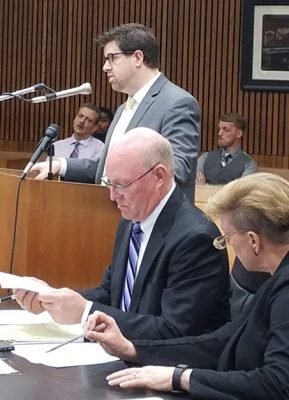
Defense attorney Clint Hubbell argues on behalf of his client Cortez Davis, while Asst. Prosecutors Tom Dawson and wife Lori Dawson wait their turn. Dawson asked for 28-40 years and expressed cynicism about Davis’ remorse.
“Cortez served six months of the constitutional sentence Judge Jones gave him before it was appealed,” his attorney Clint Hubbell said after the hearing. “This new sentence is an unconstitutional ex post facto violation. These judges now know appeals courts will kick back any sentences [differing from the statutes].”
On March 28, an Appeals Court overturned Wayne County Circuit Court Judge Bruce Morrow’s re-sentencing of Zerious “Bobby” Meadows, 63, to 25 -45 years after he had served nearly 46 years in a felony murder case. The court kicked his case back to Judge Morrow, who will conduct a hearing Friday, May 12, at 9 a.m.
Davis lauded Judge Morrow for adhering to the spirit of Miller and Montgomery, in an article published below “Why Impede on Their Freedom?” He also questioned the motivation of Wayne County Prosecutor Kym Worthy in continuing to challenge a sentencing judge’s right to determine when enough is enough.
Davis’ brother, grandmother and another relative attended the hearing, along with a cousin of Raymond Davis, Jr., who said she believed Davis had not shown remorse or “found Jesus.” In an interview with VOD after the hearing, Davis’ brother Andre Parks expressed his regret that Judge Walker had not allowed Davis to be released with time served. But he and his grandmother, who cared for Davis and his siblings at various times, both said they would be waiting with open arms for Davis to finally come home.
Above: Davis’ brother Andre Parks reacts to his sentencing.
Atty. Hubbell was to meet with his client this week to decide how to proceed from the outcome of the April 27 hearing.
Meanwhile, the rest of Michigan’s juvenile lifers face more cruel and unusual punishment as their re-sentencings creep along. The State Appellate Defenders Office (SADO), which has been assigned and paid by the state to represent juvenile lifers without attorneys, refused earlier to challenge the resentencing statutes as the ACLU is doing.

DR. DEATH: Medical care in Michigan prisons.
SADO recently published a list of juvenile lifers who had been resentenced as of April 27. Out of 364 known cases, only 68 juvenile lifers have been resentenced, according to their list. All of them have received 60 year maximums, a practice condemned by many in the judicial world as nothing but another life sentence.
Conditions in Michigan’s prisons are harsh, with extremely poor medical treatment and dietary practices.
Juvenile lifer Charles Lewis, who has been incarcerated for 41 years, told VOD that prisoners call the head doctor at Lakeland Correctional Facility “Dr. Death,” because they frequently do not return alive from the prison hospital. He said they are often given the option of being “medicated to death,” i.e. placed on high doses of pain-killing drugs, since they are dying from lack of care anyway. He said many take that option.

Curtis Clark, 45, died 10/12/16

Bennie Clay, 66, died 1/16/2016.
“I am currently on the bunk that Benny Clay was on before he died,” Lewis wrote. “He died from complete medical neglect. For over a year he complained about back pain. And, for a year the prison doctors told him that it was the sciatic nerve in his back. When they finally decided to treat him he was terminally ill. Jerome “Beno” Haywood used to talk to me every day. We filed pleadings in the same courts at the same time. He started complaining about back pain, then went to the hospital and died. I worked in the kitchen with a young kid that wasn’t born when I got locked up [in 1976], Curtis Clark. He was the dining room lead, and I was the relief lead. He complained about back pain for two years. When they finally decided to treat him he was terminally ill.

Charles Lamont Lewis, 58, has had 3 heart attacks, has severe diabetes
“Suffice it to say that for every one that I write about there are at least five that died that I didn’t know. Most of us that have been in here for years are racing with death. Most of us have lived past the expiration date on our birth certificates. Let it come rough or smooth surely we must bear it.” (Photos of Clay and Clark are still on MDOC website. They are listed as “DISCHARGED.”)
Lewis, who earned a culinary arts degree in prison, said prisoners themselves used to cook their own food, produced on farms they worked. Former Michigan Gov. John Engler sold the farms off. MDOC hired the notorious Aramark and Trinity Corporations to provide food for their profit. Lewis said the private workers do not have food-handlers certificates, or training as cooks. He said they use rotten unwashed produce and do not clean the kitchens or machines and utensils properly if at all.
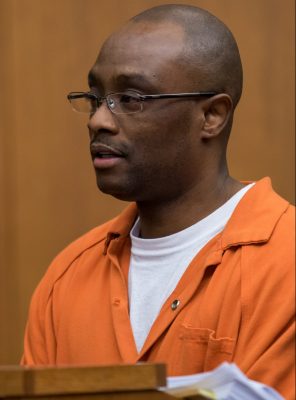
Juvenile lifer Bosie Smith.
Out of the 68 re-sentenced prisoners on SADO’s chart, only 18 have actually been released from these horrors on parole, with eight more having seen the parole board and awaiting promised release. Twenty-one of the juvenile lifers have been subjected to Davis’ situation, where they still must serve MORE time before they become parole eligible, ranging up to 30 additional years. Eighty-five percent of the prisoners are Black. On average, they have served a total of 27 years so far. Their average age when they were incarcerated was 16.
One example is Bosie Smith, 16 when he went to prison. He has served almost 25 years, but was resentenced to 31-60 years after the prosecutor first recommended another JLWOP sentence. Smith was the subject of two stories in MLive, linked below this story. One focused in particular on his work in a program at Lakeland Correctional Facility, training rescued dogs to be guide dogs and companions. That program is also at the Thumb Correctional Facility, where Davis is incarcerated. Davis wrote about it previously in a story for VOD.
See SADO chart at http://voiceofdetroit.net/wp-content/uploads/Resentenced-JLWOP-Clients-4-27-17-in-pdf-from-Excel.pdf
Michigan’s juvenile lifer resentencing statutes also forbid the use of “good time” credits that many prisoners like Davis achieve, further lengthening the time to be served under the state statutes.
Many counties have asked that dozens of their juvenile lifers be re-sentenced to JLWOP, grossly violating a U.S. Supreme Court directive that “only the rarest child” should be deemed incorrigible and sent back to die in prison. Prosecutors’ briefs regarding these prisoners are generally boiler plate, giving no reasons why they consider them incorrigible.
WHY IMPEDE ON THEIR FREEDOM?
By Cortez Davis El

Cortez Davis El
The United States Supreme Court made it perfectly clear that juvenile lifers who are now rehabilitated must be allowed to rejoin society while they are still able to contribute in a meaningful way. In two cases the highest court in the land counseled against treating child offenders like adults.
More specifically the United States Supreme Court held: “Roper and Graham establish that children are constitutionally different from adults for purposes of sentencing; because juveniles have diminished culpability and greater prospect for reform, they are less deserving of the most severe punishment.” (Miller v. Alabama, 567 U.S.___, 132 S. Ct. 2455) (2012).
Recently the Honorable Bruce Morrow tried to follow the law and constitution as interpreted by the United States Supreme Court, when three juvenile cases were in front of him. He assessed if the men before him had been rehabilitated. You can extrapolate that Judge Morrow found the three juvenile offenders that have been incarcerated for two decades mature and not a threat to society when he re-sentenced them and ordered their immediate release.
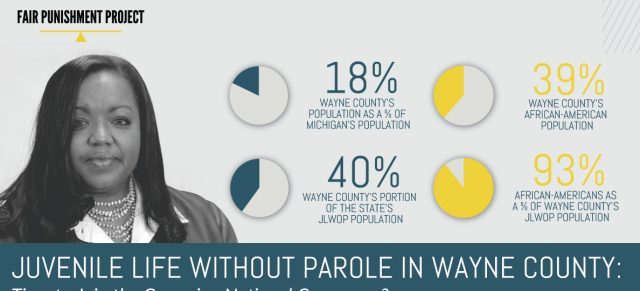 Once again the County Prosecutor [Kym Worthy] went to the high court to stop the process and impede on the freedom that the Third Circuit Judge saw fit to restore. In Montgomery v. Lousiana, 577 U.S. ___, 136 S. Ct. 718 (2016) the U.S. Supreme Court held, “If a state may not constitutionally insist that a prisoner remain in jail on federal habeas corpus review, it may not constitutionally insist on the same result in its own postconviction proceeding.” Yet the County Prosecutor is fighting to do just that and is asking the Michigan Courts to help.
Once again the County Prosecutor [Kym Worthy] went to the high court to stop the process and impede on the freedom that the Third Circuit Judge saw fit to restore. In Montgomery v. Lousiana, 577 U.S. ___, 136 S. Ct. 718 (2016) the U.S. Supreme Court held, “If a state may not constitutionally insist that a prisoner remain in jail on federal habeas corpus review, it may not constitutionally insist on the same result in its own postconviction proceeding.” Yet the County Prosecutor is fighting to do just that and is asking the Michigan Courts to help.
When the U.S. Supreme Court extended its line of precedents to include juvenile offenders that had committed homicide offenses, this restored a sentencing judge’s discretion to enforce the spirit of the Eighth Amendment’s prohibition of cruel and unusual punishment.
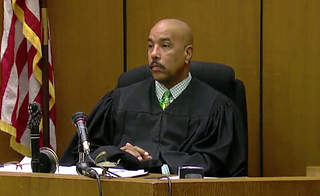
Wayne County Circuit Court Judge Bruce Morrow
The Miller Court specifically said the Eighth Amendment’s prohibition of cruel and unusual punishment “guarantees individuals the right not to be subjected to excessive sanctions.” Roper 543 U.S. at 560.
The Court went on to explain that right “flows from the basic precepts of justice that punishment for crime should be graduated and proportioned” to both the offender and the offense. If the sentencing court has discretion, then why not allow their decision to restore freedom stand? The U.S. Supreme Court did not just rely on historical precedent in their decision, but “the evolving standards of decency that mark the progress of a maturing society.”
The U.S. Supreme Court emphasized that the distinctive attributes of youth diminish the penological justifications for imposing the harshest sentences on juvenile offenders, even when they commit terrible crimes. Does this also hold true when determining if a child that has been locked away for decades is mature and rehabilitated enough to be released back into society? They have suffered continuous punishment and incapacitation. When will they be released to truly pay their debt to society by contributing to the community that they hurt?

WILL THEY LIVE TO SEE FREEDOM?
Related stories:
On Bosie Smith:
http://www.mlive.com/news/ann-arbor/index.ssf/2017/03/washtenaw_county_juvenile_life.html
http://www.mlive.com/politics/index.ssf/2016/08/in_prison_for_decades_one_juve.html
From VOD:
‘ROGUE JUSTICE!’ FREE ANOTHER INNOCENT DETROITER, CHARLES LEWIS, NOW! HEARING WED. FEB. 15 @ 9 AM.
#FREECORTEZDAVISNOW, #FREECHARLESLEWISNOW, #FREEBOSIESMITHNOW, #FREEMICHIGANJUVENILELIFERSNOW, #ENDMASSINCARCERATION, #ENDSCHOOLTOPRISONPIPELINE
UNITED GAYLE ROBINSON FAMILY: DUMP GUARDIAN MARY ROWAN, BRING MOM HOME FROM MAPLE MANOR ‘JAIL’

Earlier portrait of Robinson family in happier days. The original adorns Gayle Robinson’s living room in her Westland home.
Rowan wants Robinson permanently placed at nursing home
State, federal laws re: veteran guardianship violated
Judge Terrance Keith praises guardian widely condemned as vulture, sets next hearing for Mon. May 17, 2017
Trial date for Sharmain Sowards, who defended her mother Wanda Worley against Rowan kidnapping, set for Thurs. May 4, 2017
Worley files petition to remove Mary Rowan as guardian; hearing set for May 25, 2017 in front of Probate Court Judge David Braxton

USMC veteran Gayle Robinson with early photo of her late husband Russell, also a veteran.
DETROIT – After a fractious family battle lasting three years, Marine Corps veteran Gayle Robinson’s adult children all told Wayne County Probate Court Judge Terrance Keith April 24 that they want their mother back in her Westland home of 60 years, and notorious guardian/conservator Mary Rowan promptly dumped from her case.
Robinson is currently confined against her will in the Maple Manor nursing home in Wayne, Michigan, where Rowan placed her indefinitely without any court order. Keith had pledged during a hearing July 28, 2014, that he would not allow Robinson to be removed from her home without such an order, according to court transcripts.
“Why I am in jail?” Robinson asked a friend of the family who told VOD she visited her at Maple Manor a few days before the hearing. Robinson told VOD during an earlier hearing that she wanted to remain in her home with her son Randy, his daughter and her dog Fluffy, a wish which a former Guardian Ad Litem, Ella Bully-Cummings, also relayed to Judge Keith.
The friend said Robinson was sitting at a table in the corner of the Maple Manor dining room with three other residents, none of whom were eating the food placed in front of them. She said Robinson had a shriveled up hot dog and potato chips on her plate.
“When Gayle recognized me, she got up and gave me a big hug,” the friend said. They went together to the tiny room she sleeps in, but another resident who Robinson said sleeps all day occupied the bed next to a tiny TV. So Robinson does not watch the TV. When nursing home staff saw her in the room, they promptly told her to leave, she said, saying Robinson’s guardian Rowan did not want anyone visiting before her court hearing.

Mary Rowan (headshot taken outside CAYMC)
Over the past three years, Robinson has been deemed able to live on her own by medical professionals at Henry Ford Hospital, the Veterans’ Administration, and even a court-appointed evaluator, Dr. Marlena Geha.
“We have all come together,” Robinson’s daughter Mary Robinson told Keith during the hearing April 24, as the adult children crowded in front of him. “My mother’s wish is to be in her home. I will move out of my home and stay with her if she needs it. My mom is entitled to [in-home] care as a veteran. But instead over $5,000 of her insurance money has been spent at Maple Manor, out of $9,000.”
She said Rowan’s assistant Katie McDonald told her that her mother is not eligible for VA in-home care.
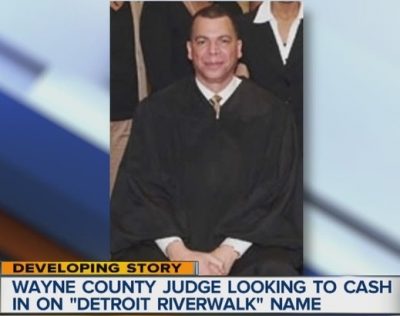
Judge Terrance Keith; scandal erupted when he tried to copyright Riverwalk name for his profit.
Other siblings at the hearing expressed unanimous agreement that their mother should be back at home, and that Rowan should be removed as guardian/conservator.
“I lived in my mom’s house for six months every night,” said son Ricky Robinson, referring to an agreement reached with McDonald that someone be with Robinson at all times. “But I was nothing but her prison guard, so we stopped. I kept visiting her with my kids. Please let Randy move [back] in with my mother and get rid of Mary Rowan.”
Randy and his daughter Lynette had been living peacefully with Robinson, who was active in VA affairs and other events, and was able to manage her own home and financial affairs, when her oldest daughter Kathleen Law opened probate proceedings in 2014.
Keith later ordered Randy out of the home and even jailed him for three months at Rowan’s request after his mother fled to her brother’s home in California to avoid placement in a nursing home. Keith’s order in the matter, which included a ban on family members commenting in the media on Gayle Robinson’s situation, received negative coverage on a national blog, run by Mary Sykes, in an article titled, “Worst and most amazing gag order imaginable.”

Gayle Robinson home of 60 years in Westland.
According to court testimony, Robinson fell twice during the period she was living on her own after her other children were not able to stay with her on a 24/7 basis in 2015. She was hospitalized once with non-life-threatening injuries.
The hospital released her with a recommendation that she use a walker, but did not say that she needed around-the-clock care. Evidently, Rowan never considered purchasing a “Life Alert” necklace for her ward. One press of the Life Alert button, used by many seniors living on their own, summons emergency medical personnel.
Randy Robinson, who has contended all along that his mother needed no guardian or conservator, said, “She feels like she’s in prison [at the nursing home]. “She can’t stand being there. She wanted to be here today and I don’t know why she’s not.”

Randy Robinson with daughter Lynette
Rowan filed a petition asking that Keith have Robinson remain at Maple Manor and that Mary Robinson pay all her guardian/conservatorship fees for the disputed time.
When a guardian is appointed for an individual, they are given a notice of their rights. It is highly questionable whether Rowan and her assistant McDonald have adhered to the following, among those laid out by the state:
- You have the right to get an independent evaluation of your condition at your own expense. If you cannot afford to pay for the evaluation, the court will approve reasonable costs at public expense. (Gayle Robinson presented numerous reports earlier on, but they were ignored by Judge Keith.)
- You have the right to be present at the hearing. If you wish to be present at the hearing, all practical steps must be taken to ensure your presence, including moving the site of the hearing.
- You have the right to have your incapacity and the need for a guardian proven by clear and convincing evidence.
- You have the right to have the guardian’s powers and the time period of the guardianship be limited to only the amount and time necessary.
- You have the right to send an informal letter to the judge asking that your guardianship be modified or ended.
- You have the right to have a hearing within 28 days of requesting a review, modification, or termination of your guardianship.
- You have the right to consult with the guardian about major decisions affecting you, if meaningful conversation is possible.
- You have the right to be visited by your guardian at least once every three months.
- You have the right to have the guardian secure services to restore you to the best possible state of mental and physical well-being so you can return at the earliest possible time to managing your own affairs.

Rowan chief assistant Katie McDonald; still shot from video when she and Westland cop took Rowan from her home in 2014 without a court order.
Rowan, her assistant Katie McDonald, current Guardian Ad Litem Maria Vulaj, and Anna Duba, Maple Manor LPN and director of Admissions and Case Management, contended that Robinson needs 24/7 care based on statements they presented in Vulaj’s report during the April 24 hearing.
Duba testified, but as an LPN she is not qualified to diagnose patients.
One of two written statements is from Senior Wellness Group, which has the same address as Maple Manor, 3999 Venoy Road, Westland, MI. Maple Manor is a for-profit organization run by the Evangelista Group, which constructed the building, according to state records.
Another statement, which misspelled Gayle Robinson’s name as Gail Robinson, is from Trupti Patel, MD. It says in one sentence that Robinson has dementia and therefore needs 24/7 care.
They alleged the Veterans Administration has refused to release an evaluation of Robinson performed Feb. 27, 2017, because of publicity attendant on the case, largely from VOD.
Keith ordered them to subpoena the records.

Evangelista family celebrating profits from their nursing homes.
The Michigan’s Uniform Veterans’ Guardianship Act 321 of 1937 says, “The administrator of veterans affairs, or his successor, is and shall be a party in interest in any proceedings brought under any law of this state for the appointment of a guardian of a veteran of any war or other beneficiary on whose account benefits of compensation, adjusted compensation, pension or insurance or other benefits are payable by the veterans administration.”
It further requires that the VA must examine any potential ward considered mentally incompetent before any VA funds can continue to be paid out. It also bars guardians with 10 wards from acting as a veteran’s guardian. Mary Rowan has over 400 active wards, and at least 1400 probate cases of various sorts.
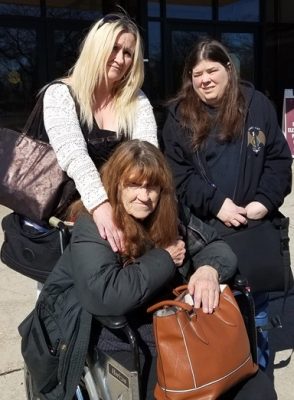
Debbie Fox (r) joined Sharmain Sowards and her mother Wanda Worley at 33rd District Court in Woodhaven earlier for trial on “assault” charges brought against Sowards for legally defending her mother from Mary Rowan’s seizure without a court order. Hearing was canceled, moved to Thurs. May 4. On May 2, Wanda Worley filed her own petition to remove Mary Rowan as her guardian. A hearing will be held May 25, 2017 in front of Judge David Braxton. (See link to petition below.)
“It’s totally illegal, a federal offense that any Court should take a veteran that receives Federal benefits in as a ward of the state if it was not said by the VA that the Ward needs to be put in guardianship,” Gayle Robinson’s daughter Debbie Fox told VOD.
During the hearing, Judge Keith lifted an earlier “show cause” order against Fox, part of the one which preceded her brother Randy’s three-month stint in jail.
Randy Robinson is now represented by attorney Matt Chaiken, who told Judge Keith he would draft an order for the family to present to the judge regarding Rowan’s removal as guardian/conservator and Robinson’s return to her home. Judge Keith set the next hearing for Monday, May 17, 2017.
Keith also spent several minutes condemning the adult children of the Robinson family for their earlier divisions, and said HE selected Mary Rowan as guardian because she is a “tough” attorney needed in such disputes.
So far, property records show Rowan has not been able to get control of the Westland home, but many guardians eventually profit from their wards’ estates by taking their homes. As conservator, Rowan does currently control Robinson’s income from the Veterans’ Administration and other sources. Court records show she was granted four extensions before finally filing an income report from the opening of her conservatorship to January of 2016.
This reporter had filed a formal request to cover the hearing using audio and visual equipment with the Probate Court’s deputy administrator. On entering the court, she was informed that Keith had granted the request. Later, however, Rowan marched back into Keith’s chambers.
Keith returned to the bench after a break, and announced that he had been advised that the only legal videotaping of a Probate Court hearing is that done by the court itself. He said the court video would be provided on request.
 Rowan asked that all camera/cell phones be seized and that all email accounts be investigated. Keith did not grant that request, a gross example of unconstitutional prior restraint of the media, violating the First Amendment.
Rowan asked that all camera/cell phones be seized and that all email accounts be investigated. Keith did not grant that request, a gross example of unconstitutional prior restraint of the media, violating the First Amendment.
This reporter was informed today by Keith’s court clerk Jamille Hill that the videotape would not be released, but that she would be required to hire a court reporter at her expense to transcribe the hearing. Since VOD is a pro bono newspaper, published on the editor’s fixed income, Judge Keith will thus have to excuse any errors made in this story. This reporter and others have had no problems audiotaping and videotaping court proceedings in other Wayne County Courts.
RELATED DOCUMENTS:
Wanda Worley’s letter to judge demanding Mary Rowan’s removal due to violation of Worley’s rights as a ward and Rowan’s duties as guardian.
http://voiceofdetroit.net/wp-content/uploads/Official-declaration-of-Wanda-Worley.pdf
RIGHTS UNDER MICHIGAN LAW RE: GUARDIANSHIP APPOINTMENTS:
Rights of an individual with a guardian:
http://voiceofdetroit.net/wp-content/uploads/Rights-of-individual-with-guardian.pdf
Powers and duties of a guardian:
http://voiceofdetroit.net/wp-content/uploads/Powers-and-duties-of-guardian-mcl-700-5314.pdf
Michigan Mental Health Code re: placement of wards with developmental disabilities
http://voiceofdetroit.net/wp-content/uploads/MICHIGAN-MENTAL-HEALTH-CODE-RE-PLACEMENT-OF-WARDS.pdf
Guardianship petitions: Summary under Michigan Law
http://voiceofdetroit.net/wp-content/uploads/Guardianship-petitions-Summary-under-Michigan-Law.pdf
RELATED STORIES:
MARY ROWAN KIDNAPS AGAIN! SUPPORT SINGER SHARMIAN, CHARGED FOR PROTECTING MOM
#FREEGAYLEROBINSON, #FREEWANDAWORLEY, #FREESHARMIAN, #JUSTICE4RAYMONDDAVIS, #JAILMARYROWANJOHNCAVATAIONOW, #ENDGUARDIANABUSE
DETROIT YOUTH PROTEST WAYNE CO. JAIL DEALS; DEMAND SCHOOLS, HOUSING, WATER, NOT PRISONS, POLICE
Black Youth Project 100, Michigan Abolition Alliance, Mertilla Jones, others demand end to new Wayne Co. Jail, Dan Gilbert’s gentrification of Detroit
Protest held at new jail construction site during rush hour April 21, 2017; dozens honked horns in support
Group previously disrupted Feb. 16 Wayne County Commission meeting where commissioners voted $500,000 to study Gilbert jail swap proposal
Mertilla Jones announces protest on 2nd anniversary of 19-year-old dad Terrance Kellom’s execution by Detroit and ICE, to be held Thurs. April 27 from 1-3 pm outside the Frank Murphy Hall, Gratiot and St. Antoine
By Diane Bukowski
April 25, 2017
DETROIT — As evening rush hour traffic raced down Gratiot April 21, youth from Black Youth Project 100 and others, including Mertilla Jones, grandmother of Aiyana Jones, protested outside the foreboding structure of the half-done Wayne County Jail, calling for millions to be spent on schools, housing, and water for the people instead.
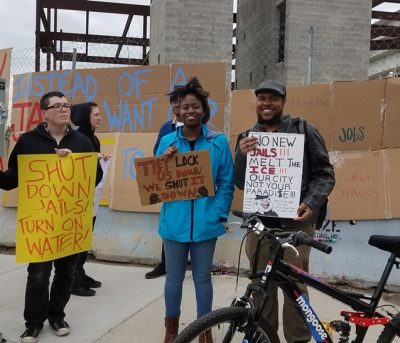
Yana (center) was among these protesters outside the failed Wayne County Jail site April 21, 2017
“I don’t want to see any jail, abolish jails, stop mass incarceration of Black people, it’s all connected,” a young woman named Yana told VOD.
“We have money to support stadiums and jails, but a bunch of schools closing, that’s fine. The school to jail pipeline is so obvious right now, like crowded schools, kids get disinterested, kids get ignored, and the next thing you know they’re in the streets, they haven’t learned anything. It’s perfect for the people in charge—all you have to do is lock ’em all up, put ’em away, and you can have all the white people come and enjoy all the fruits of the labor. It’s not OK.”
David Langstaff of the Michigan Abolition Alliance said the group earlier disrupted a Wayne County Commission meeting on multi-billionaire developer Dan Gilbert’s proposal to build a soccer stadium at the failed jail site, while constructing an entirely new “justice complex” at the current site of the Wayne County Lincoln Hall of Justice (Youth Division) on East Forest and I-75.
Langstaff and others demanded a complete end to prisons and police as they are currently configurated, calling instead for people’s “restorative justice.” He said the group’s fight against mass incarceration began with support for a national strike by prisoners Sept. 9, 2016, on the anniversary of the historic Attica prison rebellion in 1971. Prisoners from Michigan’s Kinross Correctional Facility took part. (See http://voiceofdetroit.net/2016/09/12/remember-attica-michigans-kinross-prisoners-join-nationwide-strikes-protests/)
Arthur, a leader of Black Youth Project 100, a national organization, spoke at the rally. He said the group has chapters here in Detroit, Chicago, New York City, and New Orleans, among others. They have a Facebook page at https://www.facebook.com/BYP100 and a website at http://byp100.org/.
The Detroit Public School system, largely under state-appointed CEO’s and emergency managers, has shut down over 224 schools in the city beginning in 2005 with its initial closing of 50 schools. Last year, the entire district was demolished and replaced with the “Detroit Public Schools Community District.” The previous DPS was left to pay off the gargantuan debt accumulated by the state during its reign since 1999.
The state recently claimed it would not shut 24 more schools “for the time being,” but would hand over such classic historic schools as Durfee Middle/Elementary to a “non-profit” organization called “Life Re-Modeled,” which intends to transform them into incubators for entrepreneurs. Many activists in Detroit continue to fight the closures as depicted in the video by We the People of Detroit and Kate Levy below.
The Last Cut? We the People of Detroit Documentary on School Closings from Kate Levy on Vimeo. (One correction by VOD: the closings did not begin in 2009, but in 2005 as covered by this author in the pages of the now defunct Michigan Citizen. The state first took over the district in 1999 despite the fact that it was running a budget surplus and students’ grades were on the rise.)
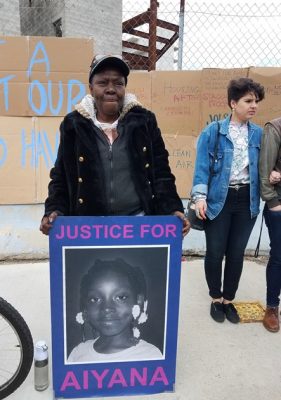
Mertilla Jones, still grieving over police slaughter of 7-year-old Aiyana Jones May 16, 2010
Mertilla Jones, who was sleeping with her seven-year-old granddaughter Aiyana Jones when a military-style Detroit police raid team broke into their home May 16, 2011, and shot the child to death, joined the protest at the Wayne County Jai as well.
She called for the youth present to attend a protest called by P.O.S.T. (Protect Our Stolen Treasures) on the second anniversary of the multi-police task force execution of Terrance Kellom April 27, 2015.The protest will take place Thurs. April 27, 2017 from 1 to 3 p.m. at the Frank Murphy Hall across the street from the Wayne County Jail ruin.
Jones said she will not stop fighting the system that slaughtered her beautiful granddaughter and has incarcerated Aiyana’s father Charles Jones and his brother Norbert Jones for crimes they did not commit. They are part of the 2.5 million people incarcerated in the U.S., which has five percent of the world’s population, but 25 percent of its incarcerated population.
Jones was at the protest to represent P.O.S.T. as well, part of a national coalition of families and friends who have lost loved ones to police violence.
PROTEST ON 2ND ANNIVERSARY OF TERRANCE KELLOM’S EXECUTION BY I.C.E., DETROIT POLICE
Thurs. April 27, 1 to 3 pm,
Frank Murphy Hall of Justice, Gratiot at St. Antoine in downtown Detroit.

Posted in Uncategorized
Leave a comment
FREE MICH. JUVENILE LIFER CORTEZ DAVIS NOW; LET JUSTICE ‘ROLL DOWN LIKE WATER;’ HEARING APRIL 27

National monument in honor of Dr. Martin Luther King, Jr.
Cortez Davis: key juvenile lifer case challenges Michigan’s merciless re-sentencing statutes
Davis’ sentencing judge, the Hon. Vera Massey Jones, called JLWOP unconstitutional 18 years before the USSC did, in Miller v. Alabama
Hon. Shannon Walker to conduct re-sentencing Thurs. April 27, 2017 @9am in Frank Murphy Hall
By Diane Bukowski
April 26, 2017

Cortez Davis (Facebook)
DETROIT – Tomorrow, Detroiter Cortez Davis, whose first Judge Vera Massey Jones condemned juvenile life without parole as unconstitutional in 1994, 18 years before the U.S. Supreme Court agreed in Miller v. Alabama, faces re-sentencing before Judge Shannon Walker in the Frank Murphy Hall of Justice at 9 a.m.
Will Judge Walker, just elected in 2014, pay heed to words of her elder, Judge Massey Jones, just retired, who said in 2012:
“. . . .This court held [in 1994] that to sentence this defendant to natural life in prison was cruel and unusual punishment. . . .The U.S. Supreme Court has finally held in Miller v. Alabama that to sentence juveniles to life in prison without the possibility of parole is cruel and unusual punishment. This court says ‘finally held’ because Mr. Cortez Davis has been in prison for 18 years without a parole hearing. . .Thus we have locked him behind bars for over 18 years as a juvenile who did not pull the trigger, who told the victim he held at gunpoint that everything will be alright, and who had the potential to be rehabilitated. We, the people of the State of Michigan, have treated this juvenile, now man, inhumanely.”
Cortez Davis, 16 when he went to prison after a horrendous childhood, is now asking Judge Walker, through his attorney Clinton Hubbell, to give him the sentence Judge Massey Jones originally called for. Hubbell contends every day of the 21 years he has served so far is now part of an unconstitutional sentence as declared by the U.S. Supreme Court.

WCCC Judge Shannon Walker

Retired Judge Vera Massey Jones
Davis is asking for, “Reinstitution of the September 26, 1994 sentence for First-Degree Felony Murder of 10-40 years, with proper credit for time served of 21 years as opposed to a sentence of 25-40 years (min) – 60 years (max) pursuant to MCL 769.25a(4)(c), for the reason that MCL 769.25a(4)(c) is an unconstitutional ex post facto law as applied to Cortez; . . . . That Cortez be immediately released, or deemed immediately parole-eligible.”
It will take courage for Judge Walker to follow in her predecessor’s footprints, in a state and county which have vigorously fought U.S. Supreme Court decisions on juvenile life without parole (JLWOP) every inch of the way. Michigan has the second highest number of juvenile lifers in the country, and Wayne County has the highest number in the state of Michigan.
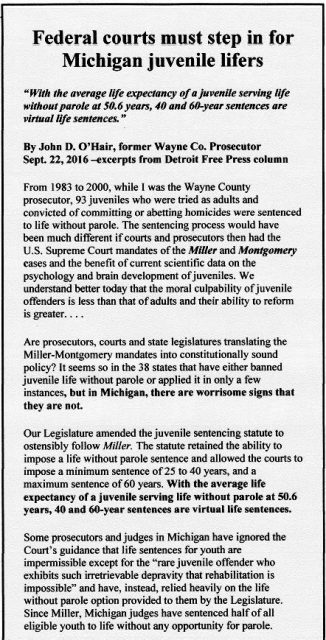
Excerpt from John O’Hair’s column.
Michigan legislators who enacted MCL 769.25a deliberately sabotaged the intent of Miller v. Alabama and the USSC’s successor opinion that Miller was retroactive in Montgomery v. Louisiana. They passed statutes inserting what they termed mandatory time limits for re-sentencing of juveniles.
Those time limits have been condemned by a host of retired Michigan legal luminaries, including former Wayne County Prosecutor John O’Hair, former Michigan Governor William Milliken, and numerous advocacy groups. O’Hair even called for federal courts to step in to rectify what he termed the gross injustice of re-sentencing juvenile lifers to maximums of 40 to 60 years, which he termed nothing more than more than renewed life sentences.
“There are many juvenile lifers that have already started trying to contribute to society while still incarcerated,” Cortez Davis said in an article published in VOD. “A few of them are housed at the Thumb Correctional Facility in Lapeer, where Cortez Davis El, Jose Burgos, Keith Maxey of Wayne County and Dontez Tillman of Oakland County are members of the G.O.A.L.S. Program, where we share our stories with at risk youth that are brought in by various agencies.”
He also cited Burgos’ work counseling suicidal prisoners, and the work of others in Stiggy’s Dogs, which “with the help of these individuals, transforms battered, abandoned, and abused dogs into service dogs and pets for veterans living with PTSD and other traumatic brain injuries and elders that need companionship.
(See full article at http://voiceofdetroit.net/2016/09/27/mich-citizens-support-2nd-chances-for-juvenile-lifers-state-county-prosecutors-induce-fear/ )
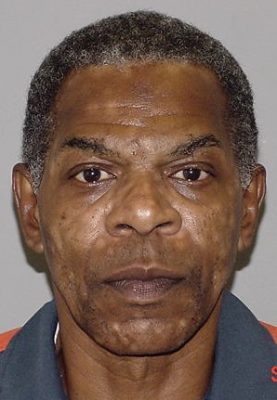
Zerious “Bobby” Meadows
A Michigan Appeals Court ruled March 28 against Wayne County Circuit Court Judge Bruce Morrow’s re-sentencing of Zerious Meadows, a juvenile lifer who has been incarcerated for over 47 years, to 25-45 years. It claimed Morrow must sentence him to the maximum of 60 years. Meadows is now 63, and was sent to die in prison when he was 15, in 1972. With conditions of inadequate medical care and unhealthy food in the Michigan prison system, he may not survive that long.
In his article, Davis asked for the same thing Dr. Martin Luther King, Jr. demanded, that justice “roll down like water and righteousness like a mighty stream.”
“Understand that the changes we’ve made didn’t start once the U.S. Supreme Court made the 2012 decision (Miller v. Alabama) nor once they made the 2016 decision (Montgomery v. Louisiana),” Davis said. “We saw the need for change long before the possibility of freedom existed for us. We want to contribute to society’s growth, not its destruction. We don’t want just anyone living next to our loved ones and we know society feels the same way about all that they love and vowed to protect. We no longer threaten the community. So instead of fearing our release, help us become successful upon release by advocating for the tools that are needed.”
The details of Davis’ individual case are spelled out in a “sentencing memorandum” submitted by Attorney Hubbell to Judge Walker, which cites his numerous accomplishments in prison, and says that his firm wants Davis to come work for it as a paralegal due to those accomplishments.
See full memorandum at http://voiceofdetroit.net/wp-content/uploads/Sentencing-Memorandum-Cortez-Davis.pdf.
Some related stories (more cited within those stories):
http://voiceofdetroit.net/2016/09/27/mich-citizens-support-2nd-chances-for-juvenile-lifers-state-county-prosecutors-induce-fear/ (Article by Cortez Davis-El)
Posted in Uncategorized
1 Comment
HUNDREDS JOIN RASMEA AT PLEA HEARING APRIL 25, IN DETROIT; U.S. AG LAUCHES NEW ATTACK ON PALESTINIAN-AMERICAN ACTIVIST

Rasmea Odeh thanks her supporters outside the Detroit federal courthouse June 13, 2016.
Assistant U.S. Attorney Jonathan Tukel appears to want to sabotage the plea agreement
WHEN: Tuesday, April 25th, 2017, at 1:00 PM Eastern Time (rally at 1:00 PM, hearing starts at 2:30 PM)
WHERE: U.S. District Court, 231 W. Lafayette Blvd., downtown Detroit, Michigan
MEDIA CONTACT: Hatem Abudayyeh, 773.301.4108, hatem85@yahoo.com
DETROIT — On Tuesday, April 25th, Palestinian American icon Rasmea Odeh will be joined in a Detroit courtroom by supporters from across the Midwest. There, Judge Gershwin Drain will consider the plea agreement Rasmea signed in March, which ended a three-and-a-half-year legal battle against immigration violation charges brought against her.
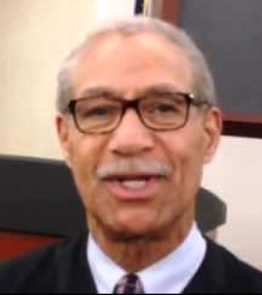
U.S. District Court Judge Gershwin Drain
Rather than risk 18 months or more of imprisonment, and the possibility of indefinite detention by Immigration and Customs Enforcement (ICE), Rasmea will plead guilty to Unlawful Procurement of Naturalization, lose her U.S. citizenship, and be forced to leave the country. However, she will exit the U.S. without serving any more time in prison or ICE detention, a victory considering the government’s sought after sentence of 5-7 years.
The plea agreement took away the chance for zionist Assistant U.S. Attorney Jonathan Tukel to grandstand in support of the Israeli occupation of Palestine; so on April 21st, he filed a Memorandum to enter into the record a number of points that were rejected by Rasmea in the plea negotiations, claiming that he would be able to “prove” that she committed “terrorist” acts and was a member of a “designated terrorist organization.”
Rasmea’s lead defense attorney Michael Deutsch and his team immediately filed a motion in response, denying any of the “facts” alleged by Tukel, and accusing the government of political posturing. Judge Drain has not yet ruled on either filing.

Numerous reports have documented Israeli torture of women and children.
The 69-year old Rasmea was tortured and sexually assaulted by the Israeli military in 1969, and spent 10 years imprisoned by the Israelis, until she was released in a negotiated prisoner exchange. Years after her release, Rasmea came to the U.S. as a permanent resident to care for family, later becoming a naturalized citizen and making a home for herself in Chicago. When she was indicted in 2013, almost 20 years after she arrived here, the government claimed that Rasmea’s immigration documents were not in order. The case against her was never about immigration; it was always about attacking the Palestine liberation movement.
In her 2014 trial in U.S. federal court, where Rasmea was convicted and sentenced to 18 months in prison for allegedly giving false answers to questions on her applications for permanent residency and citizenship, Judge Drain barred the defense from challenging the legality of the 1969 Israeli military tribunal. Rasmea was not allowed to explain that she suffered from Post-Traumatic Stress Disorder as a result of the torture, but she won an appeal and a new trial expressly based on the excluded torture evidence. The crimes of Israel would have been part of that new trial.
However, just weeks before the re-trial was to take place, Tukel unveiled a vindictive new superseding indictment, falsely accusing Rasmea of being a “terrorist” and a member of a “designated terrorist organization.” These new allegations laid bare the government’s motivation in this case, to criminalize the cause of Palestinian liberation. Rasmea would be on trial for her lifetime of dedication to that cause. It is impossible to imagine a fair trial for any Palestinian in an immigration case framed around accusations of “terrorism.”

Prof. Angela Davis, Frank Chapman of Chicago Alliance and Rasmea Odeh at 2015 rally.
Tens of thousands of people across the U.S. have rallied in support of Rasmea over the past three-and-a-half-years, including many organizations and individuals within the Movement for Black Lives, the anti-torture movement, and the sexual assault survivors’ movement, respectively. She is embraced by the women’s rights movement as well, having been celebrated on International Women’s Day this year. And over 1,000 members of Jewish Voice for Peace gave her repeated standing ovations at their national member meeting in Chicago earlier this month.
Hundreds of these supporters from Chicago and other parts of Illinois, as well as from Milwaukee, Detroit / Dearborn, Grand Rapids, Ann Arbor, Minneapolis / St. Paul, Ohio, Indiana, and other Midwest areas are already committed to stand with Rasmea at the Tuesday, April 25th hearing, and rally with her outside.
Previous related stories:
http://voiceofdetroit.net/2016/02/26/rasmea-odeh-may-get-new-trial-us-appeals-court-rules/
Posted in Uncategorized
Leave a comment
FAMILY FILES FEDERAL LAWSUIT IN POLICE KILLING OF TERRANCE KELLOM; FATHER: ‘PROS. WORTHY MUST GO’
Video above shows attorney Nabih Ayad (front), l to r Kenneth Reed, Kimberly Davis and Yolanda McNair of P.O.S.T., Yvette Johnson holding Terrance Kellom’s infant daughter Terranae, Nelda Kellom, Kevin Kellom
Lawsuit says police, prosecutor conspired in cover-up; that Terrance was in custody, had hands up, no hammer when gunned down
‘Why did you fucking shoot?’—Detroit cop to ICE agent Mitchell Quinn
‘They can’t print enough money that would compare to my son; they need to be in prison’—Father Kevin Kellom
“Feet to Fire” protest April 27, 2017 on 2nd anniversary of Terrance Kellom’s death, from 1-3 pm at Frank Murphy Hall in downtown Detroit
By Diane Bukowski
April 13, 2017

Terrance Kellom, then 19, with infant son Terrance Desmond. A mass march was held from his father’s home down Chicago the day after his death, and more protests followed. Channel 7 video shot.
DETROIT –“The police are not being held accountable,” Kevin Kellom, father of Terrance Kellom, told VOD April 12, regarding a wrongful death lawsuit his family filed in federal court April 6. The suit targets members of a federal task force that gunned down his 20-year-old unarmed son, a father of two, April 27, 2015, in front of his family, sparking mass protests.
“I want Kym Worthy to step down,” Kellom added. “She has refused to charge any officer held in any type of police murder. Now that she justified them killing my son in front of my face, there is no other way to go but a civil suit. But they can’t print enough money that would compare to my son. They need to be in prison.”

ICE agent Mitchell Quinn, who killed Terrance Kellom.
Prominent civil rights attorney Nabih Ayad filed the suit, naming Terrance’s mother Nelda Kellom as representative of his estate (seen in red in video above behind Terrance Kellom). Defendants are Immigration and Customs Enforcement (ICE) agent Mitchell Quinn, and Detroit police officers Darell Fitzgerald and Treva Eaton, all part of the U.S. Marshall’s Detroit Fugitive Apprehension Task Force (D-FAT).
The suit charges that police conspired with the prosecutor to cover up the true circumstances of Kellom’s death, claiming falsely that he threatened cops streaming into his father’s home with a hammer after first pounding a hole in an upstairs closet and jumping into a first floor bedroom.
In fact, it says, Kellom was coming down the stairs, unarmed and already in custody with his hands up when Quinn gunned him down.
 Kellom’s fingerprints were not found on the hammer, which was lying on the living room floor when he entered, only blood spray from his execution-style killing, says the lawsuit.
Kellom’s fingerprints were not found on the hammer, which was lying on the living room floor when he entered, only blood spray from his execution-style killing, says the lawsuit.
After sealing the Kellom autopsy report and other evidence for months, Wayne County Prosecutor Kym Worthy refused on Aug. 19, 2015 to bring criminal charges against Quinn. Quinn formerly worked for the Detroit Police Department but was suspended after facing brutality lawsuits and criminal charges there. He was hired six months later by ICE.
The autopsy report showed that Kellom had been shot four times, including once in the right lower back. Three other shots struck him in front, in his neck, chest, and thigh. Worthy said at a press conference that seven shell casings were found.
“This is usual with Kym Worthy’s office—stall the case, interfere with it, block evidence, and then dismiss any charges,” the late Cornell Squires of the Original Detroit Coalition Against Police Brutality said during a protest after Kellom’s police execution.
“Kym Worthy cannot be trusted. You have to do your own independent investigation. We tried to encourage the family to get a second autopsy report, because we knew this was going to go down. Kym Worthy is for sale when it comes to police officers.”
The suit says Detroit cop Fitzgerald falsely told Terrance’s father Kevin and sister Teria that he had a search warrant in order to gain entry. In fact, he had an arrest warrant related to an alleged armed robbery, which did not allow access.
“Despite having an opportunity to prevent the shooting, Defendant Eaton waited until all shots were fired before she exclaimed ‘Why did you fucking shoot!’” the lawsuit adds. “Defendant Quinn then rushed out of the scene.”

Hundreds marched down W. Chicago from Kellom home April 28, 2015.
Kellom said in agony, “I just don’t get it. How can they bring my son down the stairs and shoot him in my face? I live with this every day. I have no life anymore. I don’t go anywhere, and I’m not able to work. I’ve worked the majority of my life since I was nine years old; my dad taught me that. I barely allowed Terrance’s mother to whip him. But then this cop comes to my house and kills my son, before he even got to see his daughter born? I couldn’t kill his son and get away with it.”

Kevin Kellom with Janay Williams (in pink) and her sisters, holding baby Terranae at rally June 18, 2015. Terrance did not live to see his daughter’s birth.
Terrance Kellom’s children with Janay Williams are Terrance Desmond Kellom, now three, and Terranae Destiny Kellom, now two. They were at the press conference where Ayad announced the lawsuit April 6. Terrance Desmond is in front of Kevin Kellom, and Terranae Destiny is being held by Yvette Johnson, Kellom’s fiancée.
“Every time the door opens, he says, ‘There go Daddy, here come Daddy,’” Kellom said about his grandson. “He asks his mom almost every night, ‘When’s Daddy coming home?’”
Kellom said he suffers from Post-Traumatic Stress Syndrome (PTSD), for which he is on medication, and that Nelda Kellom’s health has also been adversely affected.
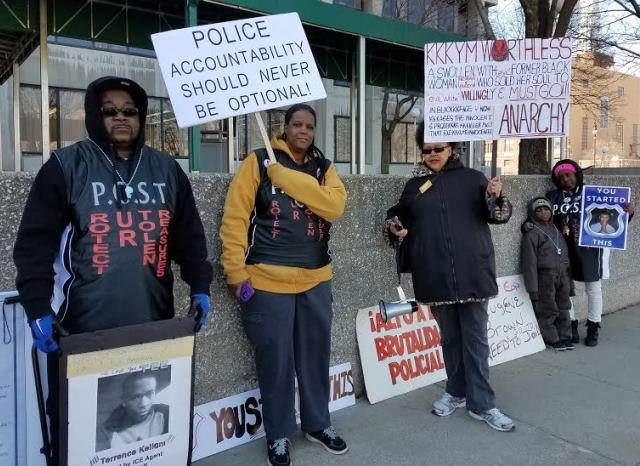
Members of P.O.S.T. call for Kym Worthy to step down at protest outside Frank Murphy Hall March 22, 2017
Kellom is now working with a group called “Protect Our Stolen Treasures” (P.O.S.T.), part of a national coalition of organizations seeking justice for families who have lost loved ones to police violence. It is headed by Yolanda McNair, whose daughter Adaisha Miller died after a Detroit cop’s gun went off as they were dancing together at a party in the cop’s home (seen behind Yvette Johnson in videos above.)
Other Detroit members include Mertilla Jones, grandmother of Aiyana Jones, killed by Detroit police at the age of 7 in 2011, and Kimberly Davis, mother of Kimoni “Kodak” Davis, killed in an Ohio state trooper chase (seen at left in videos above.)
They protested March 22 outside the Worthy’s headquarters at the Frank Murphy Hall of Justice, demanding that she resign. Kellom says they will protest there again on the second anniversary of his son’s death, Thursday, April 27, from 1-3 pm.
PROTEST KYM WORTHY, FEDS AND DETROIT POLICE 2ND ANNIVERSARY OF TERRANCE KELLOM DEATH
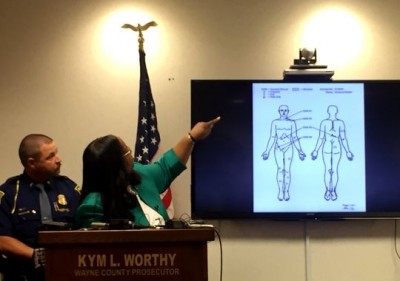
Prosecutor Kym Worthy at press conference Aug. 19, 2015 announcing no charges in Kellom death, pointing to autopsy diagram of bullet wounds, one in his back.
THURSDAY, APRIL 27, 2017, 1-3 PM FRANK MURPHY HALL, GRATIOT/ST ANTOINE, DOWNTOWN DETROIT
Kellom family lawsuit vs. cops who killed Terrance Kellom:
DONATE TO  VOD at https://www.gofundme.com/VOD-readers-up
VOD at https://www.gofundme.com/VOD-readers-up
Related stories:
#JailKillerKops, #Justice4TerranceKellom, #Justice4AiyanaJones, #Justice4AdaishaMiller, #Justice4KimoniDavis, #DownwithPoliceState


